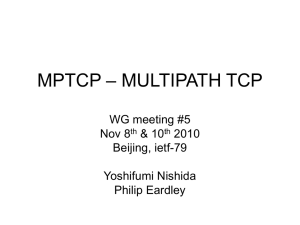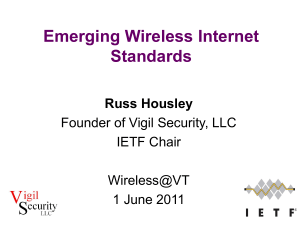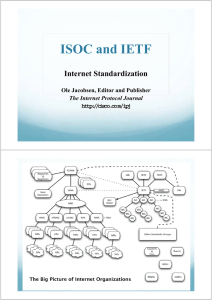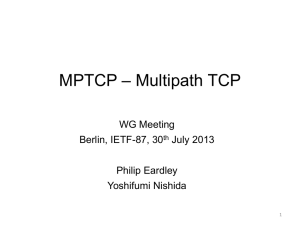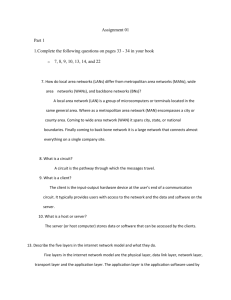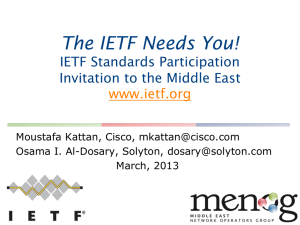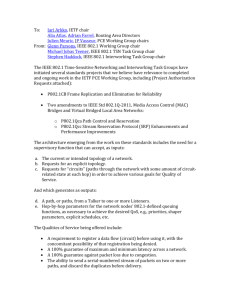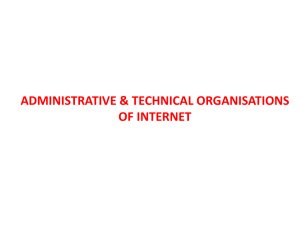slides
advertisement
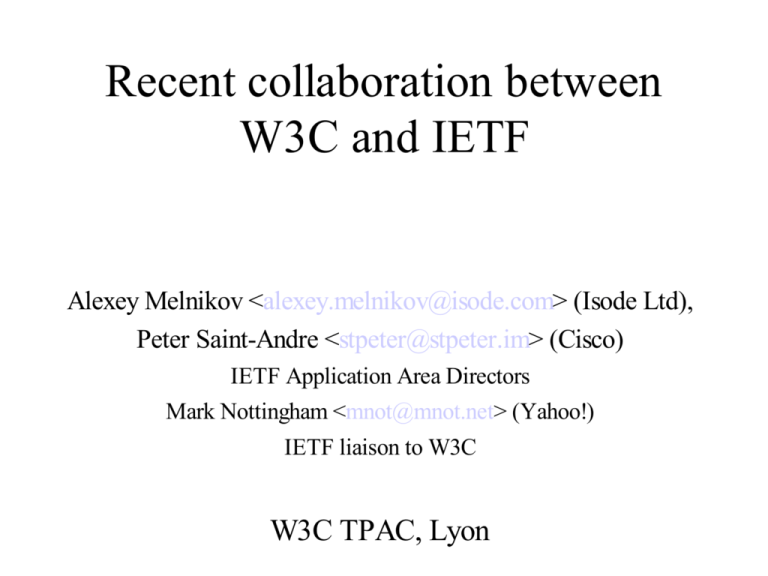
Recent collaboration between
W3C and IETF
Alexey Melnikov <alexey.melnikov@isode.com> (Isode Ltd),
Peter Saint-Andre <stpeter@stpeter.im> (Cisco)
IETF Application Area Directors
Mark Nottingham <mnot@mnot.net> (Yahoo!)
IETF liaison to W3C
W3C TPAC, Lyon
Outline
• Short introduction to IETF
– Structure
– Standardization process
– Decision making process
• How W3C and IETF work together
–
–
–
–
Examples
Recently completed IETF work
Joint W3C/IETF projects
IETF and IANA
• Conclusions
Organizational structure of IETF
• ISOC – umbrella organization
• IAB
– architectural guidance for IETF
– oversees IANA function (defines IANA policies)
– handles appeals against IESG decisions
• IESG
– Day to day running of IETF
– Manages IETF Areas, creates/closes WGs, reviews/approves
documents (RFCs)
• Different IETF Areas
– 8 at the moment (Applications, Real-time Applications and
Infrastructure (RAI), Security, Transport, Internet, Operations &
Management, Routing, General)
– Each has 2 Area Directors (ADs), except for the General Area
– ADs manage Working Groups (WG)
– 14-30 WGs per Area, each has 1-3 WG Chairs
How IETF standardization works
(1 of 2)
• No formal membership in IETF; volunteer effort, fees only
for face-to-face meetings
– Decisions have to be made on mailing lists, not in person
– But face-to-face meetings are useful for brainstorming,
sensing directions of work
• No IPR licensing requirements (only disclosures)
– IPR disclosure requirements are fairly strict (and very
early)
– IETF community is allowed to consider IPR licenses
during decision making process
• e.g. when choosing between multiple proposals
• Better technology with a worse IPR can be rejected in
favor of a worse technology with better IPR
How IETF standardization works
(2 of 2)
• WGs have some discretion about their internal processes /
tools used
• Design teams (closed groups) are allowed, but not always
used
• IETF produces multiple different types of documents (RFCs)
– Standards Track (similar to W3C Recommendation Track)
– Informational (similar to W3C Note)
– Experimental
– Historic
– Not all RFCs are a product of IETF!
• There are other RFC “streams”
Why IETF works ... (1 of 2)
• IETF mostly focuses on protocols and interoperability
on the wire, not APIs and UI. IETF also frequently
works on formats.
– But there are exceptions
• IETF typically attracts a broad spectrum of
implementers -- including server developers and
those of other protocols -- thereby leading to broader
review and adoption
• Historically IETF has been more successful with
finishing something invented elsewhere, than with
designing something from scratch
Why IETF works ... (2 of 2)
• IETF prefers to select a single proposal among
multiples
– Multiple competing standards approved as RFCs
are unusual
– When there are multiple competing standards,
IETF usually regretted it
• “Rough Consensus” and “Running Code”
• Decisions are mostly based upon technical merit
– No voting! (unless need to select one of the
proposals which otherwise are considered equal)
– decisions can be first appealed to WG Chairs, then
the responsible ADs, then IESG, then IAB
... and why sometimes it doesn't
• See the previous 2 slides :-)
IETF is a consumer of W3C
standards
•
•
•
•
•
•
HTML/XHTML
XML
XML Schema
XPath, XQuery, ...
SVG image format
...
W3C is a consumer of IETF
standards
•
•
•
•
•
•
•
MIME – Internet Media Types, ...
Language Tags
vCard
Internationalized Domain Names (IDNA)
URI/IRI schemes, URI IANA registry
SSL/TLS
...
Language Tags
• RFC 5646 (Tags for Identifying Languages) and
RFC 5645 (Update to the Language Subtag Registry)
– Published in September 2009 as replacements for RFC
4646 and RFC 4645
– Add more than 7,500 new primary and extended language
subtags
– Can be used in XML (e.g. xml:lang), HTML and other
places
– <http://www.w3.org/International/articles/languagetags/Overview.en.php>
• fr-CA (French as used in Canada)
• sl-IT-nedis (Slovenian as used in Italy, Nadiza dialect)
• en (English)
URI schemes
• RFC 6068: The 'mailto' URI scheme
• RFC 5870: A Uniform Resource Identifier for
Geographic Locations ('geo' URI)
– geo:45.7264,5.0908,240
• RFC5724: URI Scheme for Global System for
Mobile Communications (GSM) Short Message
Service (SMS)
– sms:+447753759732?body=Your%20W3C%20presentati
on%20is%20great
• “about:” (draft-holsten-about-uri-scheme-04.txt)
– is being reviewed for publication
IDNA
• "IDNA2008" replaces "IDNA2003" (RFC 3490)...
–
–
–
–
–
–
RFC 5890: framework
RFC 5891: protocol
RFC 5892: classification tables
RFC 5893: handling of right-to-Left scripts (Bidi)
RFC 5894: rationale
RFC 5895: optional character mapping
Other recently published IETF
RFCs
• RFC 5785: Defining Well-Known Uniform Resource
Identifiers (URIs)
– robots.txt could have lived under .well-known
• RFC 5854: The Metalink Download Description
Format
• RFC 5789: PATCH Method for HTTP
• RFC 5995: Using POST to Add Members to Web
Distributed Authoring and Versioning (WebDAV)
Collections
• RFC 5987: Character Set and Language Encoding
for Hypertext Transfer Protocol (HTTP) Header Field
Parameters
Other current IETF activities of
interest to W3C
• IETF Precis WG
– preparation and comparison of internationalized strings
for application protocols (SASL, LDAP, XMPP, etc.)
– this might eventually be used by HTTP
• Revision of URNs specs
– IETF URNBIS WG is about to be chartered by IESG
– updates to base spec (RFC 2141) and several key
namespace registrations (ISBN, ISSN, bibliography
numbers)
• IETF OAuth WG
• Documenting use of long polling, etc.:
– draft-loreto-http-bidirectional-05: Best Practices for the
Use of Long Polling and Streaming in Bidirectional HTTP
Joint projects between W3C and
IETF (1 of 2)
• XML Digital Signatures
• Atom Syndication Format (RFC 4287), Atom
Publishing Protocol (RFC 5023) and various
extensions
• Web Linking registry (RFC 5988!) and extensions
– e.g. RFC 5829: Link Relation Types for Simple Version
Navigation between Web Resources
• IETF Geopriv WG / W3C Geolocation WG
• IETF HTTPBIS WG
– Revision of HTTP 1.1
Joint projects between W3C and
IETF (2 of 2)
• Cookie (IETF HTTPSTATE WG)
– draft-ietf-httpstate-cookie-17.txt: complete and accurate
documentation of how cookies actually work on the web,
obsoletes RFC 2109 and RFC 2965
• WebSec
– Same origin policy and possibly a more generic Web security
framework
– Strict transport security
• e.g. “only talk to this website using https”
• HYBI
– WebSocket protocol
– Not working on APIs (work in W3C)
• IRI
– Revision to RFC 3987, incorporates LEIRI work from W3C
IETF and role of IANA
• IETF makes extensive use of IANA registries
• IANA only administers the registries, it doesn't define
policies
– IANA does what IETF tells it through published RFCs
• Each registry's definition determines how it runs;
RFC5226 gives some common templates
– Some policies are very permissive: first-come-first-served
– Some are restrictive, e.g.: “Standards Track RFC”
• Copyright of IANA registries is implicitly licensed
("collection of facts"); explicit license being discussed
• There's work between the IETF and W3C regarding
streamlining of IANA process, coordination
Other ongoing projects
• Workshop on Internet Privacy
– Hosts: W3C, IAB, ISOC and MIT
– Dates: December 8 and 9, 2010
– Location: Massachusetts Institute of Technology
– Topic: "How Can Technology Help to Improve Privacy on the
Internet?"
– submit position papers to privacy@iab.org by November 5
– http://www.iab.org/about/workshops/privacy/
• Discussion about differing use of MIME types in email and web
• Contact API
– vCard 4.0 / XML mapping
– possible future work between IETF, W3C, OMA, Portable
Contacts, etc.
• HTTP Streaming
Conclusions (1 of 2)
• Both IETF and W3C do important and relevant work
– work is complementary
• Many ongoing collaboration projects
– Some work better than others
• Understanding process/culture differences helps
– How decisions are made
– Participation
• Closed groups versa open groups
– IPR rules
Conclusions (2 of 2)
• Collaboration can always be improved
– Continuous and honest dialog between W3C and IETF
improves results of collaboration
– Dialog between W3C and IETF management is important
– Informal dialog between W3C and IETF engineers is
equally as important
– W3C liaisons to IETF: Philippe Le Hegaret <plh@w3.org
> and Thomas Roessler <tlr@w3.org>; IETF liaison to
W3C: Mark Nottingham <mnot@mnot.net>
